The Justice League of America was rife with archetypes—the Amazon princess, the invulnerable alien (times two!), the lord of the oceans. Today we’ll look at three characters who are equally archetypical in their own ways and who, in many ways, helped to shape the JLA as we know it.
Twinkle Twinkle Little Bat
Batman is one of those characters whose history is convoluted beyond measure. There’s simply so much to tell and not nearly enough time to wade through it. The funny thing about Batman is that he is a contradiction unto himself. He demands trust and loyalty, but he rarely trusts anyone and is generally not a team player.
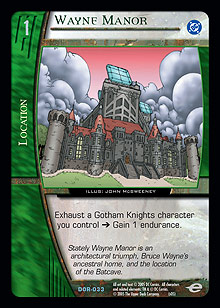 To understand Batman, I’ll give a little back story. If you’ve seen Batman Begins, you already have a basic idea of Batman’s history, as his origin in the film is fairly close to his origin in the comics. Batman was born Bruce Wayne, the son of Thomas Wayne, a wealthy Gotham industrialist, and his wife, Martha. When he was six years old, while wandering through the field behind Wayne Manor, young Bruce fell into an underground cavern filled with bats.* This filled him with a deep-seeded lack of personal security—a sense of mistrust of the very world around him. Then, when he was eight years old and leaving a movie theater through the back door, Thomas and Martha Wayne were gunned down in the alleyway by a low-life hoodlum named Joe Chill . . . right in front of the a Bruce.
To understand Batman, I’ll give a little back story. If you’ve seen Batman Begins, you already have a basic idea of Batman’s history, as his origin in the film is fairly close to his origin in the comics. Batman was born Bruce Wayne, the son of Thomas Wayne, a wealthy Gotham industrialist, and his wife, Martha. When he was six years old, while wandering through the field behind Wayne Manor, young Bruce fell into an underground cavern filled with bats.* This filled him with a deep-seeded lack of personal security—a sense of mistrust of the very world around him. Then, when he was eight years old and leaving a movie theater through the back door, Thomas and Martha Wayne were gunned down in the alleyway by a low-life hoodlum named Joe Chill . . . right in front of the a Bruce.
Bruce was raised from then on by his uncle, Philip Wayne, though much of the raising was done by the faithful family butler, Alfred Pennyworth. Together with social worker Leslie Thompkins, they helped Bruce work through the trauma. Though they could ease his passage through his growing years, they could not eliminate the hatred of the criminal world and the distrust of humanity that developed within Bruce; from the time his parents were murdered, he made a solemn oath to eliminate every criminal in Gotham.
When Bruce turned eighteen, he hit the road. He had trained himself to the point of obsession and he felt that he had reached his physical peak. He now needed the type of training that weightlifting and track running could not provide; he needed the tools to meet and defeat the criminals on their own ground. Not just fighting skills, but tracking, hunting, detection, espionage, problem solving . . . even criminal psychology and mental warfare. He even served briefly in the FBI (six weeks or so) to help him gain access to government files and to receive government-style field training.
In his early twenties, after several years of training and learning, he felt ready to take up the mantle of vengeance that he had foresworn on his parents’ graves. He returned to Gotham City and began his crusade against crime. At first, he wore no costume, but he later adopted the costume of his childhood trauma—a bat. This way, he could face his fears head on, day in and day out, and use his own trauma as an advantage against those he hunted; he would strike the same fear and terror into the criminals that he had felt as a young child when confronted with those creatures of the night.
Bruce became Batman, a creature of the night in his own right. Working mainly at night, he was swift and harsh with his vigilante justice, but he would not sink to the level of the criminals he hunted; he would not kill them, nor would he use guns. Instead, he’d hand them over to the law. However, he was aware of corruption in the system and worked to ensure that the criminals were not handled with kid gloves. He gained formidable allies within the justice system, such as District Attorney Harvey Dent (who would later become Two-Face) and Lieutenant James Gordon, one of the few Gotham policemen who would not succumb to corruption. Gordon eventually became a Captain and then the Commissioner.
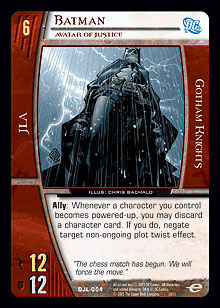 On the JLA team, we have Batman, Avatar of Justice.** For Batman is truly the earthly representation of justice incarnate in the DC universe. He has no superpowers, but he is wilier and has a quicker mind and better problem solving capabilities than just about anyone else. He is a 6-drop because his power level is very high, and even though he has no super strength, super speed, or heat vision, he finds ways to take down whomever he needs to. His ability ties in with his flavor text (“The chess match has begun. We will force the move.”) and his mindset—Batman is not a team player, even though he is sometimes featured on teams. He always has an agenda, and everything he does on a team functions to serve his own needs at the moment. He is willing to sacrifice position to come out on top in the end and his success is paramount, regardless of his teammates. If that means allowing a teammate to fall to stop a villain, then so be it . . . even if he has to take that teammate down himself. His ability is therefore backhanded; while it triggers on the powering-up of a character you control, you have to discard a card to use it. He is negating an effect—trumping an opponent’s move—by sacrificing a pawn. And it’s significant that it’s an ally ability and not a leader ability; he will not make such a move unnecessarily, but in the heat of combat, he will win by any means necessary.
On the JLA team, we have Batman, Avatar of Justice.** For Batman is truly the earthly representation of justice incarnate in the DC universe. He has no superpowers, but he is wilier and has a quicker mind and better problem solving capabilities than just about anyone else. He is a 6-drop because his power level is very high, and even though he has no super strength, super speed, or heat vision, he finds ways to take down whomever he needs to. His ability ties in with his flavor text (“The chess match has begun. We will force the move.”) and his mindset—Batman is not a team player, even though he is sometimes featured on teams. He always has an agenda, and everything he does on a team functions to serve his own needs at the moment. He is willing to sacrifice position to come out on top in the end and his success is paramount, regardless of his teammates. If that means allowing a teammate to fall to stop a villain, then so be it . . . even if he has to take that teammate down himself. His ability is therefore backhanded; while it triggers on the powering-up of a character you control, you have to discard a card to use it. He is negating an effect—trumping an opponent’s move—by sacrificing a pawn. And it’s significant that it’s an ally ability and not a leader ability; he will not make such a move unnecessarily, but in the heat of combat, he will win by any means necessary.
Like a Flash of Light . . .
It’s ironic that the man who would become “the fastest man alive” was always late for everything and never seemed able to catch up to everyone else. Then, while working late in his lab one evening, lightning struck through the window, shattering several chemicals, mixing them together, and dousing Barry Allen with the resulting mess.
Cursing his bad luck, Barry called it a night and left the lab, only to miss the only cab in sight. Trying to run it down, Barry discovered that he had suddenly passed the cab and was running much faster than the cab was going. Realizing what had happened, he decided to become a hero in honor of his idol, Jay Garrick, the original Flash. He took his name, as well.
Unlike Batman, who ruled the Gotham nights through terror and fear, the Flash was a friendly and open individual who fought crime publicly. His hometown, Central City, embraced him and called itself “the home of the Flash.” He took the entire country by storm, sparking fan clubs and garnering a celebrity status.
The Flash would battle crime in Central City for many years, often alongside Ralph Dibny (a.k.a. Elongated Man). He also took in young Wally West as a sidekick, who would be known as Kid Flash and then as Impulse before eventually becoming the Flash himself. As well, Barry at one point discovered Keystone City, home of his hero, Jay Garrick, who he rescued from the Fiddler and the Thinker. Garrick would return the favor several times, helping Barry save his own city from the growing legion of criminals gathering in Central City.
These criminals began to work together in several combinations and eventually became known as the Rogue’s Gallery. They included the aforementioned Thinker and Fiddler, along with several others including Captain Cold, Captain Boomerang, Heat Wave, the Mirror Master, Gorilla Grodd, James Jesse ◊ Trickster, and Professor Zoom (a.k.a. the Reverse Flash). Professor Zoom traveled back in time to replace Barry as the Flash, only to find that he had been murdered by Barry in that timeline. Driven insane by the temporal paradox, he tried to kill Barry before Barry could kill him, and then he tried to take Barry’s place at his wedding to Iris. When that failed, he tried to convince Iris to marry him instead of Barry. Driven more and more insane through the various travels back and forth along the timeline, he snapped and killed Iris when she refused him. The end result was a huge fight between Barry and Zoom that resulted in the Reverse Flash being trapped in the timeline.
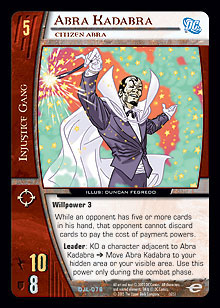 Barry would eventually get engaged again, this time to Fiona Walsh. He was in a dark time in his life after being involved in several attempts to alter certain villains’ personalities manually (such as the aforementioned Dr. Light), and he was trying to make a turn toward a more humane and responsible future. That came to a halt on his wedding day when he was forced to kill the Reverse Flash to prevent him from killing Fiona. The result was a trial for manslaughter, during which Abra Kadabra manipulated the jury for a guilty verdict and permanent damage to Barry’s status.
Barry would eventually get engaged again, this time to Fiona Walsh. He was in a dark time in his life after being involved in several attempts to alter certain villains’ personalities manually (such as the aforementioned Dr. Light), and he was trying to make a turn toward a more humane and responsible future. That came to a halt on his wedding day when he was forced to kill the Reverse Flash to prevent him from killing Fiona. The result was a trial for manslaughter, during which Abra Kadabra manipulated the jury for a guilty verdict and permanent damage to Barry’s status.
It was then that Mr. Deus Ex Machina reared his ugly head in the form of Iris Allen, who wasn’t dead after all! Her spirit had somehow ended up in the 30th century where it was rescued and instilled into a bio-engineered body that was conveniently an exact duplicate of her own body. She traveled back in time, took the place of a jury member, and helped to defeat Abra Kadabra and clear Barry’s name. Barry left Central City to live in the 30th century with Iris, leaving the mantle of the Flash to Wally.
Then came the Crisis on Infinite Earths. The Anti-Monitor captured Barry and imprisoned him on Qward, harnessing his power to fuel his war machinery while leaving his mind in the “hands” of the Psycho-Pirate. Barry eventually escaped and fought the Psycho-Pirate, battering him until he agreed to help Barry defeat the Anti-Monitor. He used his mental powers to force a group of Qwardians to start fighting amongst themselves, providing a distraction that allowed Barry to sneak into the chamber housing the Anti-Monitor’s Anti-Matter Cannon and reverse its flow of energy. When the Anti-Monitor discovered him, he opened a temporal gateway that sent the speeding Flash back in time, where he slammed through the window of Barry Allen’s lab, shattered several chemicals, mixed them together, and doused Barry Allen with the resulting mess . . .
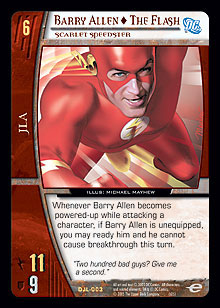 Barry Allen ◊ The Flash, Scarlet Speedster is our first glimpse into Barry’s powers. While his basic power is the ability to travel faster than the eye can see, he has used this power in all sorts of power stunts. One of those is the ability to attack faster than an opponent can react. While his strength is lower than average—only 11 ATK / 9 DEF for a 6-drop—his ability allows him to ready whenever he powers-up while attacking a character. He can’t be equipped because it would weigh him down (and would allow you to abuse activated equipment, but I digress), but it makes for an interesting situation when you combine him with activated abilities and effects. For example, imagine a Teen Titans deck with Barry Allen and Arsenal. Throw in some power-up tricks from Tamaran and New Teen Titans with the many, many power-up tricks in the JLA set (such as Disband the League, Reform the League, and Magnificent Seven), and Arsenal can receive a massive boost (not to mention the stat boost that Barry would get). Do that a few times, and Barry could potentially take down a 7-drop or boost his stats up so that your opponent’s 6-drop can’t stun you (Barry’s too fast!). And even though he can’t cause breakthrough, he could attack other characters, thus helping to clear the board.
Barry Allen ◊ The Flash, Scarlet Speedster is our first glimpse into Barry’s powers. While his basic power is the ability to travel faster than the eye can see, he has used this power in all sorts of power stunts. One of those is the ability to attack faster than an opponent can react. While his strength is lower than average—only 11 ATK / 9 DEF for a 6-drop—his ability allows him to ready whenever he powers-up while attacking a character. He can’t be equipped because it would weigh him down (and would allow you to abuse activated equipment, but I digress), but it makes for an interesting situation when you combine him with activated abilities and effects. For example, imagine a Teen Titans deck with Barry Allen and Arsenal. Throw in some power-up tricks from Tamaran and New Teen Titans with the many, many power-up tricks in the JLA set (such as Disband the League, Reform the League, and Magnificent Seven), and Arsenal can receive a massive boost (not to mention the stat boost that Barry would get). Do that a few times, and Barry could potentially take down a 7-drop or boost his stats up so that your opponent’s 6-drop can’t stun you (Barry’s too fast!). And even though he can’t cause breakthrough, he could attack other characters, thus helping to clear the board.
Barry is a scientist and his mind is as quick as his body is. This card reflects that, as he can use his speed not only to a tactical advantage, but also in less aggressive and more cunning and strategic ways.
Beware My Power - Green Lantern’s Light!
I gave a fairly detailed origin of Hal Jordan in my June 24 article, so I won’t bother to rehash the whole thing here. But here’s a brief synopsis of his early years.
Hal Jordan was the son of a fighter pilot who dreamed of the skies and stars, and he grew up to become a pilot like his father. When Abin Sur crashed on Earth, Hal was one of his two choices as a replacement (the other was Guy Gardner); he had the courage, strength of will, and spirit necessary to be a Green Lantern. Hal was closer when the time came, so he got the summons and Abin Sur bequeathed him the ring.
Hal discovered the Corps and Oa and learned how to use his ring. He became the guardian of Sector 2814, protecting Earth and its surrounding planets and systems from evil and danger. He joined the JLA for the same reasons—it was a means to protect the Earth from menace. While a Lantern’s responsibility should be first and foremost to his Sector and to the Corps, Hal put Earth above his other responsibilities. He was attached to Earth and to his teammates. In fact, one of my favorite comic moments ever was when Hal, Ollie Queen, and Clark Kent were simply having a beer and some snackages on a sidewalk terrasse (or terrace for you un-hip sidewalk cafe scenesters), off duty and in civilian clothes. It helped to humanize the heroes, though Hal and Ollie always felt human anyway.
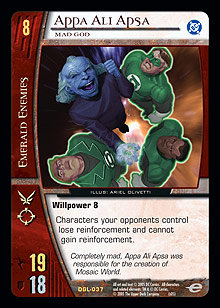 Hal’s JLA character, Hal Jordan ◊ Green Lantern, Hard-Traveling Hero brings forth those characteristics. He has the slightly above-average stats and a decent willpower of 5 to denote himself as a Lantern. But this version references the time he spent traveling through the American countryside with Oliver Queen, helping to teach Appa Ali Apsa (and through him, the Guardians) why even a single Earth life was precious enough to preserve. His flavor text shows his side of this frequent debate with Ollie (and Green Arrow’s flavor text shows his side). But right and wrong to Hal were relative terms, and his moral code included the preservation and protection of all life. He believed that the needs of the one were as important as the needs of the many.
Hal’s JLA character, Hal Jordan ◊ Green Lantern, Hard-Traveling Hero brings forth those characteristics. He has the slightly above-average stats and a decent willpower of 5 to denote himself as a Lantern. But this version references the time he spent traveling through the American countryside with Oliver Queen, helping to teach Appa Ali Apsa (and through him, the Guardians) why even a single Earth life was precious enough to preserve. His flavor text shows his side of this frequent debate with Ollie (and Green Arrow’s flavor text shows his side). But right and wrong to Hal were relative terms, and his moral code included the preservation and protection of all life. He believed that the needs of the one were as important as the needs of the many.
Hal’s ability is also about perseverance and the big picture. It’s about a battle of wills where the strength of him and his teammates and their ability to beat the odds and persevere is sometimes more important than their raw or physical strength. He can force an opponent to shift gears mid-stream, thereby giving Hal the upper hand. By forcing someone out of position, he pits his and his teammates’ will to win against that of his opponent’s, forcing them into submission. Unlike Batman, who uses his allies to further his own strategy, Hal uses his teammates to win as a team. His agenda is that of humankind’s and of his team; it’s a rare occurrence when he will strike out to serve his own purpose.
NEXT WEEK: The Magnificent Seven continue with Martian Manhunter, Superman, and Wonder Woman.
Questions? Queries? Comments? Send ’em along and I’ll try to get them answered in the column! Email me at:
Kergillian (at) hotmail (dot) com
* The ages I mention here are the commonly accepted ages, but they have been disputed. Some say he fell into the cavern when he was four, his parents died when he was six or seven, and he began traveling the world as young as fourteen or fifteen.
** Because continuity has shifted back and forth in the DC Universe (Joe Chill was written out as the killer of Wayne’s parents and Batman was written completely out of the annals of the Justice League and then put back in, but not as a founder), it is hard to place Batman’s importance in the League’s history. One thing for sure in the current JLA continuity, from Identity Crisis through the present Infinite Crisis, is that Batman is integral to the storyline and to the League’s current state of flux. It was Batman’s witnessing of Zatanna’s mind-wipe of Dr. Light and subsequent threat of action that prompted the JLA to wipe ten minutes from his mind. When Batman found out, his latent distrust surfaced again and he built a computer system to spy on the JLA. He also created countermeasures to stop the JLA should they ever become a threat. This system is the focal point of the OMAC Project. Maxwell Lord hijacked and used that system to take control of Checkmate and create the OMACs (and in Villains United, Lex Luthor seemingly used the spy satellites for his own purposes, as well). And let’s not forget that the JLA discovered during the Tower of Babel storyline that Batman had created files on every member of the JLA that included their weaknesses in case he ever had to take them down. Ra’s al Ghul got a hold of those files and nearly used them to destroy the JLA.
Also known by his screen name Kergillian, Ben Kalman has been involved in the Vs. community since day one. He started the first major online community, the Vs. Listserv, through Yahoo! Groups, and it now boasts well over 1,800 members! For more on the Yahoo! group, go to http://groups.yahoo.com/group/Marvel_DC_TCG.